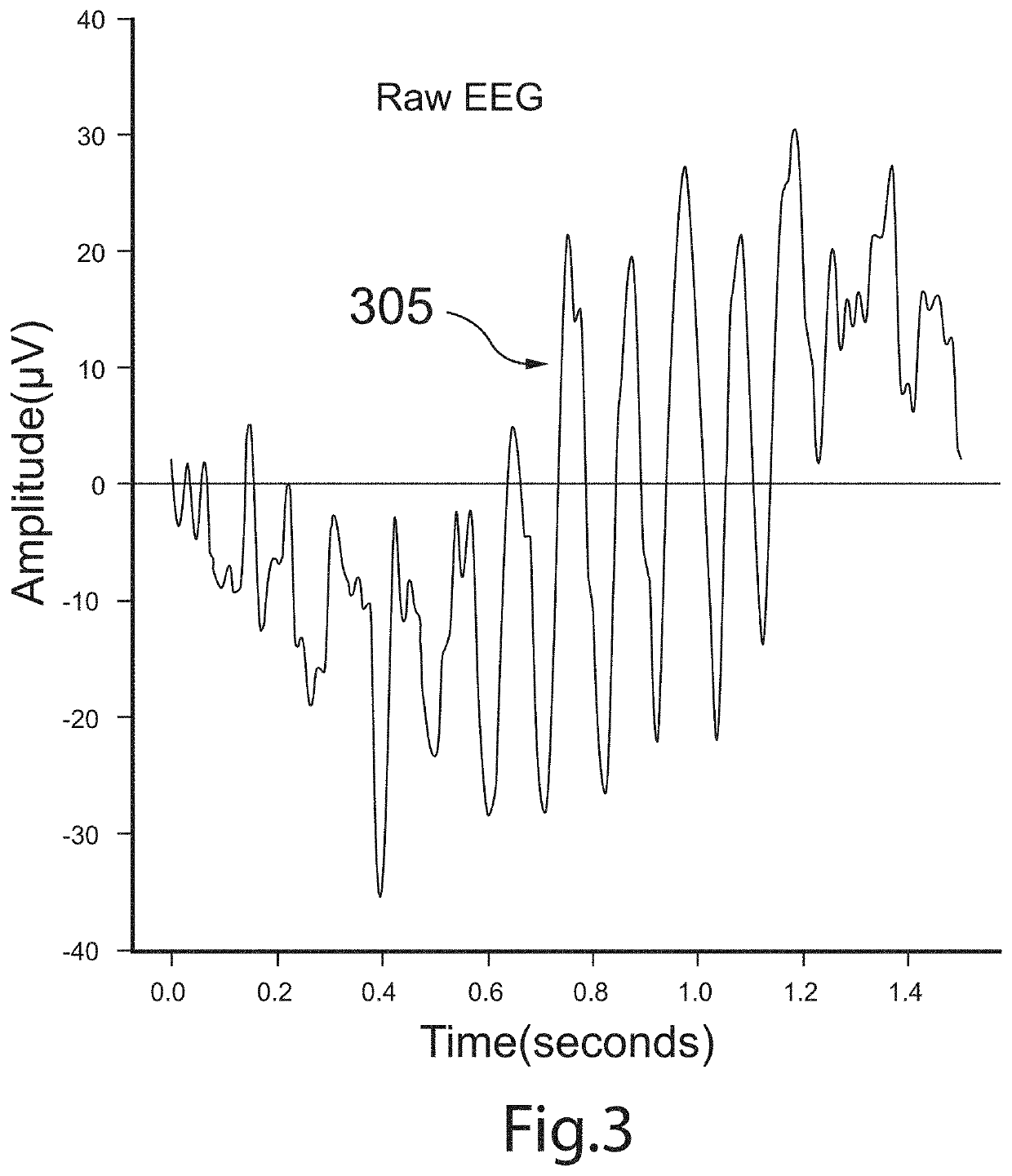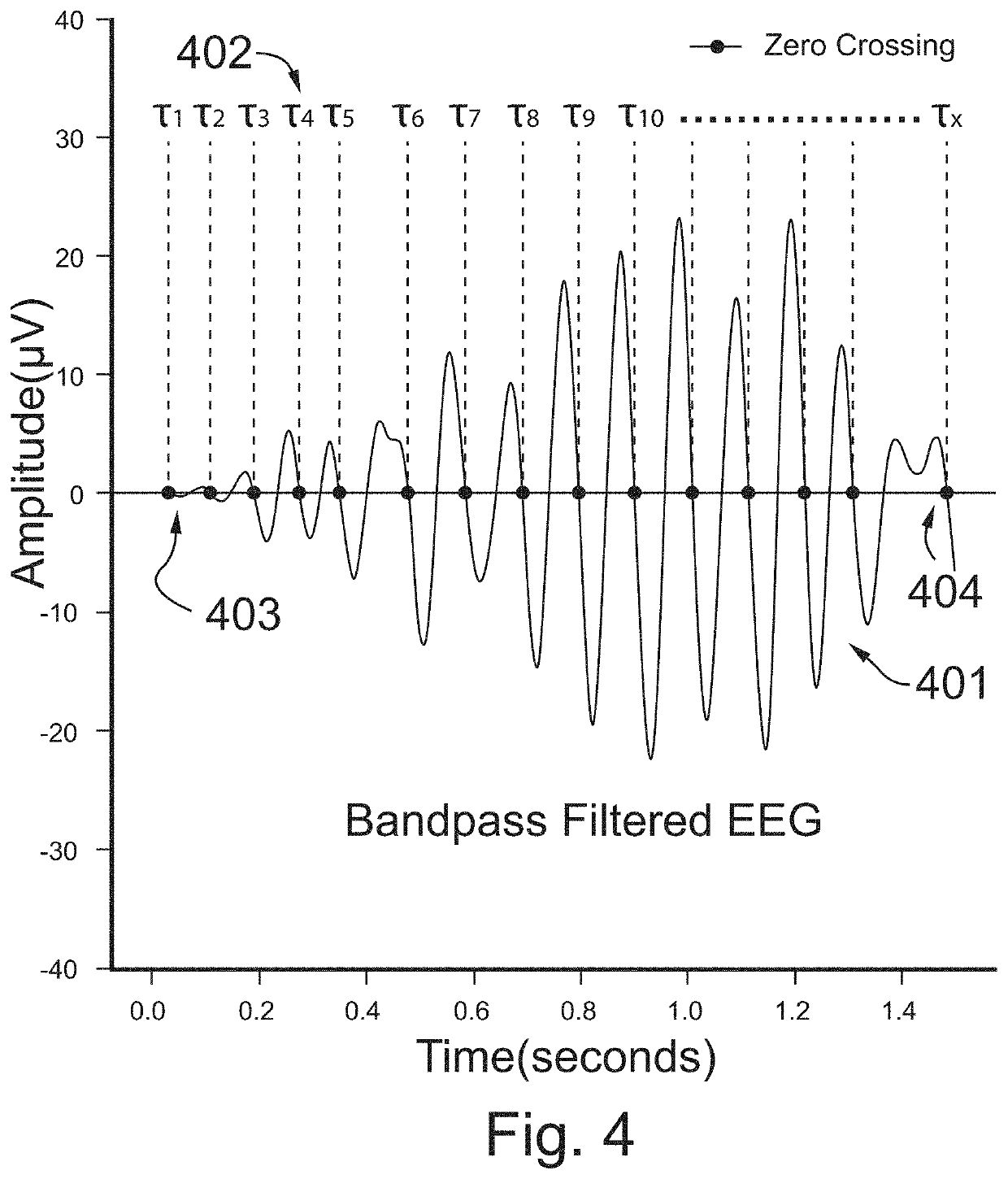Magnetic Stimulation With Random Variable Pulsed Intervals
a random variable, pulsed interval technology, applied in magnetotherapy, electrotherapy, therapy, etc., can solve the problem that wavelet analysis does not play a role in determining treatment therapy, and achieve the effect of modulating brain activity, improving symptoms, and increasing amplitude or relative power density
- Summary
- Abstract
- Description
- Claims
- Application Information
AI Technical Summary
Benefits of technology
Problems solved by technology
Method used
Image
Examples
example 1
[0044]A 69-year-old male patient with chronic Attention Deficit Disorder (ADD) and anxiety was treated with random variable repetitive transcranial magnetic stimulation (rTMS) according to the present invention. A pre-treatment EEG of the patient (FIG. 7) shows excessive slow waves globally in delta and theta frequency bands, while dominant activity remains in alpha frequency. Wavelet analyses coupled with bandpass filtering and zero-crossing count of the entire 10 min data epoch were performed to yield an EEG period variability profile by mean period and standard deviation of the dominant components of interest. The data was then idealized to a Gaussian distribution to generate 30, 6-second randomized TTL pulse trains with a mean pulse period of 107.5 ms varied between 108.7 ms and 103.1 ms to treat the patient for a 30-minute, one 6-second pulse train per minute treatment. The patient's post-treatment EEG (FIG. 7A) shows significant improvement in alpha frequency selectivity and s...
example 2
[0045]A 59-year old male patient with severe anxiety for 20 plus years was treated with random variable repetitive transcranial magnetic stimulation (rTMS) according to the present invention. A pre-treatment EEG of the patient (FIG. 8) shows increased beta activity and highly desynchronized alpha activities with low frequency selectivity, primarily in the frontal and central areas. The pre-treatment EEG was analyzed with wavelet analyses coupled with bandpass filtering and zero-crossing count of the entire 7 min data epoch to yield an EEG period variability profile by mean period (94.3 ms) and standard deviation (158.7 ms) of the dominant components of interest. The data was then idealized to a Gaussian distribution to generate 30, 6-second randomized TTL pulse trains to treat the patient for a 30-minute, one 6-second pulse train per minute treatment. The patient's post treatment EEG (FIG. 8A) after 4 days of treatments shows great improvement in alpha frequency selectivity and sync...
example 3
[0046]An 84-year-old female patient who has experienced difficulties in memory and night time sleep was treated with random variable repetitive transcranial magnetic stimulation (rTMS) according to the present invention. A pre-treatment EEG of the patient (FIG. 9) shows multiple distinct frequency components adjacent to the dominant alpha rhythm. Wavelet analyses coupled with bandpass filtering and zero-crossing count of the entire 7 min data epoch were performed to yield an EEG period variability profile by mean period (9.4 ms) and standard deviation (117.6 ms) of the dominant components of interest. The data was then idealized to a Gaussian distribution to generate 30, 6-second randomized TTL pulse trains with a mean pulse period of 116.3 ms varied between 119.1 ms and 112.4 ms to treat the patient for a 30-minute, one 6-second pulse train per minute. The patient's post-treatment EEG (FIG. 9A) shows significant improvement in alpha frequency selectivity and synchronization along w...
PUM
 Login to view more
Login to view more Abstract
Description
Claims
Application Information
 Login to view more
Login to view more - R&D Engineer
- R&D Manager
- IP Professional
- Industry Leading Data Capabilities
- Powerful AI technology
- Patent DNA Extraction
Browse by: Latest US Patents, China's latest patents, Technical Efficacy Thesaurus, Application Domain, Technology Topic.
© 2024 PatSnap. All rights reserved.Legal|Privacy policy|Modern Slavery Act Transparency Statement|Sitemap



